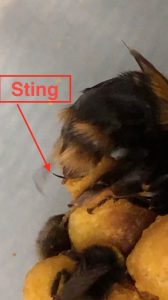Bombus terrestris queen egg laying in her nest
In the wild many new queen bumblebees fill their crop with nectar, mate and then hibernate over the winter months. A few may stay around to establish a nest depending upon species and location. See BWARS Winter Bumblebees Project. When the temperature warms up heralding the approach of spring queen bumblebees that have been fertilised by males the previous year, wake up. The first thing they need to do is to feed up to replenish the fat reserves that were used up during hibernation. For about two or three weeks queen bumblebees feed then rest up under leaves, or long grassy undisturbed tussocks for example. This gives them time to sun themselves, a safe place to rest, gives them protection from predators and shelter from inclement weather during both day and night. By moving in stages like this, they slowly disperse from their hibernation site. These queens will attempt to establish a colony. Some will not be so lucky and will never start a colony, because, in effect, they have been castrated, by a nematode worm, Sphaerularia bombi. Or they may simply die due to many other reasons such as a lack of forage, bad weather or predated.

Bumblebee queen everts her sting when egg laying
Colony Initiation
There are several steps in the queen’s life, which she must undertake prior to initiating a colony. Once she has left her hibernaculum, she will feed upon nectar, which is used as fuel to enable her to fly. Feeding upon pollen is used as protein to enlarge and develop her ovaries prior to egg laying, and has been found to be necessary for wax gland development. An early nectar and pollen source is vital for such queens, with dandelion being a source of both. Once a suitable nest site has been found, she will make a brood chamber out of any suitable material found at the nest site. She will collect pollen forming it with her mandibles into a rough mound, then lay eggs into it. She makes a wax nectar pot which she fills with nectar, which is basically her food larder when the weather is unsuitable for foraging or she needs to feed during the night. Like a bird she will sit on her eggs, keeping them warm and once the resulting larvae emerge she will feed them with a mixture of nectar and pollen. When fully developed the larva have a brief resting stage as pupae, eventually emerging as workers.
Luxury living?
The Bombus terrestris queen in this film had none of these factors to contend with. Everything she and her offspring needs are already provided. As this is not a wild bee nest, none of them will need to go outside to forage. Their food is supplied by the supplier of the bumblebees and as the nest is indoors, the queen does not need to make a brood chamber. None will ever need to undertake orientation flight. as their wild cousins will. Unless a parasitoid wasp manages to get herself inside the nest, none will ever be predated.
Egg laying role
You can clearly see the queen adding a nest laying cell above a cell probably containing a bee larva or pupa. After laying her eggs into the egg cell, she seals it over with wax. She will continue to make such egg cells and lay eggs until the workers are old enough to take some of these duties over for her. She will basically become an egg-laying bumblebee and never leave the nest again.
You can see on some workers body, the hairs at first appear to be ‘bleached’, which is shown in the film. After about 24 hours their characteristic colours will emerge. You can see they are much smaller than the queen.
Similar colony cycles
The majority of UK bumblebees species have very similar colony cycles, although spring emergence times and how the larvae feed will vary. B. Terrestris is a pollen-storing species, store pollen/nectar mixes in separate wax pots and feed each individual larvae whereas “Pocket makers” create pockets of pollen/nectar at the base of the brood cell clump and the larvae can feed themselves.
Refs: Besides my own observations, photographs and experiences;
Alford, D.V.(1975) “Bumblebees”, Davis-Poynter Ltd.
Benton, T. (2006) “Bumblebees” Harper Collins
Goulson, D. (2010) “Bumblebees. Behaviour, ecology, and conservation” Oxford University Press
Sladen, F.W.L. (1912) “The Humble-Bee” Macmillan & Co.Ltd
For more information about bumblebees visit the Bumblebee Conservation Trust
Interested in pollinators and Citizen Science visit the Buzz Club
For info and link to buy an excellent book about wild bees see the Field Guide to the Bees of Great Britain and Ireland by Steven Falk
An extremely useful resource supports this book by a special website feature within Steve Falk’s Flickr website which furnishes extra photos and other useful resources to assist with identification.
With thanks to Dr Hauke Kock, Kew Gardens, who allowed me to film his bumblebees.
Did you like this article?
“All my articles, research links and videos, available free, are funded by my teaching and sales of award-winning bumblebee nest boxes, solitary bee boxes and peanut bird feeders. Please help by spreading the word and forwarding this link to your friends and colleagues. https://nurturing-nature.co.uk Thank you” George Pilkington

Recent Comments